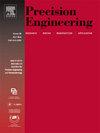Hybrid dual-stage fast tool servo for integrated machining and measurement of optical microstructures
IF 3.5
2区 工程技术
Q2 ENGINEERING, MANUFACTURING
Precision Engineering-Journal of the International Societies for Precision Engineering and Nanotechnology
Pub Date : 2025-02-26
DOI:10.1016/j.precisioneng.2025.02.023
引用次数: 0
Abstract
This study presents the development of a dual-stage force sensor integrated fast tool servo (FS-FTS) for the integrated machining and measurement of optical microstructures. The modeling, design and control of the dual-stage FS-FTS are described in detail. Specifically, the normal-stressed electromagnetic actuator (NSEA) drives the primary stage, which provides a large stroke. The piezoelectric actuator (PEA) drives the secondary stage, which achieves a high bandwidth. The mechanical-electromagnetic model and mechanical-piezoelectric model of the two stages are established, based on which a simultaneous electro-mechanical parameter optimization method is proposed for the parameter design of the FS-FTS. Then, the closed-loop position controller and force controller are both carefully designed for the ultra-precision machining and in-process inspection of optical microstructures. Finally, a process that integrates the machining and measurement is developed and a 2-dimensional (2-D) water drop surface serving as the target surface is fabricated to demonstrate the performance of the developed system. The experimental result suggests that the stroke of the primary stage achieves 288 μm and the first-order resonant frequency of the secondary stage achieves 8520 Hz. The root-mean-square (RMS) tracking error is decreased from 1.0009 μm to 0.1521 μm by using the proposed primary-secondary coordinated position controller when tracking the toolpath of the 2-D water drop surface. Furthermore, the RMS error of the fabricated surface is only 125.7 nm when the spindle speed is 1600 r/min and that of the in-process inspection process is only 55.7 nm. These results demonstrate the superiority of the developed system in terms of integrated machining and measurement.
用于光学微结构综合加工与测量的混合双级快速刀具伺服
本文研究了一种用于光学微结构综合加工和测量的双级力传感器集成快速刀具伺服系统(FS-FTS)。详细介绍了双级FS-FTS的建模、设计和控制。具体来说,法向应力电磁执行器(NSEA)驱动初级阶段,提供大冲程。压电驱动器(PEA)驱动二级,实现了高带宽。建立了两级的机械-电磁模型和机械-压电模型,并在此基础上提出了一种同步机电参数优化方法,用于FS-FTS的参数设计。然后,针对光学微结构的超精密加工和过程检测,精心设计了闭环位置控制器和力控制器。最后,开发了一种集成加工和测量的工艺,并制作了一个二维水滴表面作为目标表面来验证所开发系统的性能。实验结果表明,一级冲程达到288 μm,二级一阶谐振频率达到8520hz。采用该主辅协调位置控制器对二维水滴表面轨迹进行跟踪时,将RMS跟踪误差从1.0009 μm减小到0.1521 μm。当主轴转速为1600 r/min时,加工表面的均方根误差仅为125.7 nm,在加工过程中检测的均方根误差仅为55.7 nm。这些结果表明了所开发系统在加工和测量一体化方面的优越性。
本文章由计算机程序翻译,如有差异,请以英文原文为准。
求助全文
约1分钟内获得全文
求助全文
来源期刊
CiteScore
7.40
自引率
5.60%
发文量
177
审稿时长
46 days
期刊介绍:
Precision Engineering - Journal of the International Societies for Precision Engineering and Nanotechnology is devoted to the multidisciplinary study and practice of high accuracy engineering, metrology, and manufacturing. The journal takes an integrated approach to all subjects related to research, design, manufacture, performance validation, and application of high precision machines, instruments, and components, including fundamental and applied research and development in manufacturing processes, fabrication technology, and advanced measurement science. The scope includes precision-engineered systems and supporting metrology over the full range of length scales, from atom-based nanotechnology and advanced lithographic technology to large-scale systems, including optical and radio telescopes and macrometrology.

 求助内容:
求助内容: 应助结果提醒方式:
应助结果提醒方式:


